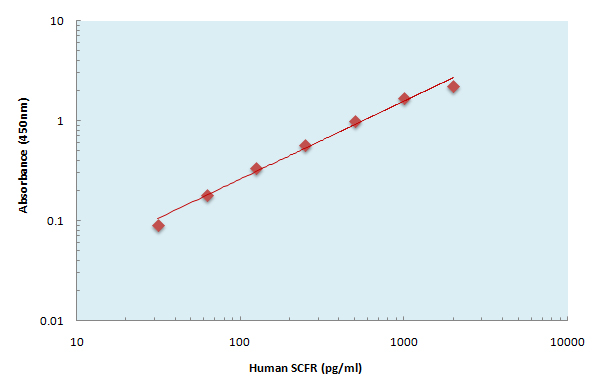- Home
- About
- Promotions
-
Products
-
Elisa Kits
- |
-
Primary antibodies
- |
-
Secondary antibodies
- |
-
Proteins
- |
-
IHC reagents
- |
-
WB reagents
- PonceauS Staining Solution
- PBST Washing Buffer, 10X
- 1.5M Tris-HCl Buffer, pH8.8
- 1M Tris-HCl Buffer, pH6.8
- 10% SDS Solution
- Prestained Protein Marker
- TBST Washing Buffer, 10X
- SDS PAGE Loading Buffer, 5X
- Stripping Buffered Solution
- Tris Buffer, pH7.4, 10X
- Total Protein Extraction Kit
- Running Buffer, 10X
- Transfer Buffer, 10X
- 30% Acr-Bis(29:1) Solution
- Tris电泳液速溶颗粒
- PBS(1X, premixed powder)
- TBS(1X, premixed powder)
- 快速封闭液
- 转膜液速溶颗粒
- Chemical reagents
- News
- Distributor
- Resources
- Contact
- Home
- >
- Info
- >
- Human SCFR ELISA Kit
- >
- Go Back
Human SCFR ELISA Kit
- Catalog No.:KE1247
- Applications:ELISA
- Reactivity:Human
- Protein Name:
- Mast/stem cell growth factor receptor Kit
- Specificity:
- Sample Type for Cell Culture Supernates, Cell lysates, Tissue Lysates, Serum, EDTA Plasma, Heparin Plasma
- Storage Stability:
- 2-8°C/6 months
- Other Name:
- KIT;SCFR;Mast/stem cell growth factor receptor Kit;SCFR;Piebald trait protein;PBT;Proto-oncogene c-Kit;Tyrosine-protein kinase Kit;p145 c-kit;v-kit Hardy-Zuckerman 4 feline sarcoma viral oncogene homolog;CD antigen CD117
- Detection Method:
- Colorimetric
- Background:
- catalytic activity:ATP + a [protein]-L-tyrosine = ADP + a [protein]-L-tyrosine phosphate.,disease:Defects in KIT are a cause of gastrointestinal stromal tumor (GIST) [MIM:606764].,disease:Defects in KIT are a cause of piebaldism [MIM:172800]. Piebaldism is an autosomal dominant genetic developmental abnormality of pigmentation characterized by congenital patches of white skin and hair that lack melanocytes.,disease:Defects in KIT have been associated with testicular tumors [MIM:273300]. It includes germ cell tumor (GCT) or testicular germ cell tumor (TGCT).,function:This is the receptor for stem cell factor (mast cell growth factor). It has a tyrosine-protein kinase activity. Binding of the ligands leads to the autophosphorylation of KIT and its association with substrates such as phosphatidylinositol 3-kinase (Pi3K).,online information:CD117 entry,similarity:Belongs to the protein kinase superfamily. Tyr protein kinase family.,similarity:Belongs to the protein kinase superfamily. Tyr protein kinase family. CSF-1/PDGF receptor subfamily.,similarity:Contains 1 protein kinase domain.,similarity:Contains 5 Ig-like C2-type (immunoglobulin-like) domains.,subunit:Interacts with APS. Interacts with MPDZ (via the tenth PDZ domain). Interacts with PTPRU.,
- Function:
- hemopoietic progenitor cell differentiation, myeloid progenitor cell differentiation, lymphoid progenitor cell differentiation, immune system development, leukocyte differentiation, myeloid leukocyte differentiation, reproductive developmental process, protein amino acid phosphorylation, membrane lipid metabolic process, glycolipid metabolic process, sphingolipid metabolic process, glycosphingolipid metabolic process, phosphorus metabolic process,phosphate metabolic process, cell motion, cell surface receptor linked signal transduction, enzyme linked receptor protein signaling pathway, transmembrane receptor protein tyrosine kinase signaling pathway, intracellular signaling cascade, protein kinase cascade, gamete generation, germ cell development, spermatogenesis, spermatid development, behavior, learning or memory, learning, visual behavior, cell death, cell proliferation, positive regu
- Subcellular Location:
- [Isoform 1]: Cell membrane; Single-pass type I membrane protein.; [Isoform 2]: Cell membrane; Single-pass type I membrane protein.; [Isoform 3]: Cytoplasm . Detected in the cytoplasm of spermatozoa, especially in the equatorial and subacrosomal region of the sperm head. .
- Expression:
- [Isoform 3]: In testis, detected in spermatogonia in the basal layer and in interstitial Leydig cells but not in Sertoli cells or spermatocytes inside the seminiferous tubules (at protein level) (PubMed:20601678). Expression is maintained in ejaculated spermatozoa (at protein level) (PubMed:20601678).

- The Human SCFR ELISA Kit allows for the detection and quantification of endogenous levels of natural and/or recombinant Human SCFR proteins within the range of 32-2000 pg/ml.




